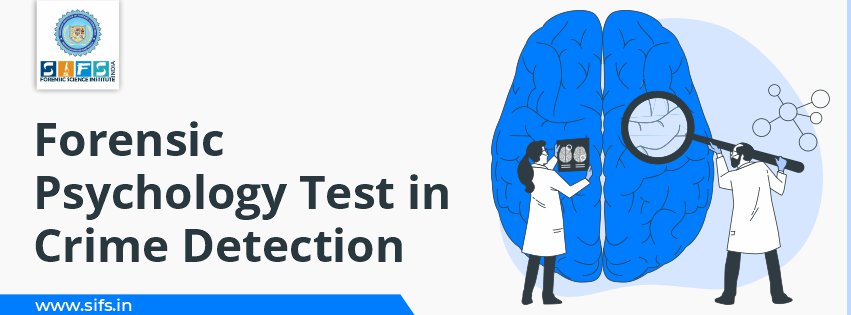- Call Us: +91 7303913002
- Email Us: education@sifs.in
Forensic Psychology Test in Crime Detection

BY SIFS India | January 20, 2025
Forensic Psychology Test in Crime Detection
Criminals use the latest technology to commit hi-tech crimes.
Crimes are more localized and organised globally. Local laws are not stringent enough to tackle present-day crimes.
They need reformation to tackle the present-day hi-tech crimes.
Forensic science, which deals with the scientific analysis of all types of evidence, also needs to upgrade its methodology to meet the scenario of hi-tech crimes.
Terrorist activity and information technology related crimes are the latest trends in countering the ever-changing trends of terrorist activities. This emphasises the forensic scientist to tune their efforts for success in pre-incident detection and crime prevention.
Forensic Psychology Test in Crime Detection
It is in Indian history right from 1917 in different forms. Shri. Prabodh Chandra Bose wrote about Juristic Psychology dealing with the study of the psychology of human behaviour related to the maker, administrator, interpreter, expositor, of law etc. He described the nature of the function of the human brain in two different plans
1) On a conscious level
2) On a subconscious level.
In the last decade, considerable progress has been made by the USA, and the UK in the field of Forensic Psychology has taken a lift-off late.
Psychology techniques like lie detectors are well in use globally over the last decade. The other techniques like Nacro-analysis, Brain Fingerprinting, Brain Signature profiling etc are the recent ones and are more practised in India.
Polygraph Test
Forensic Science has several divisions in helping the police with their investigation and interrogation process. One such division is the lie-detection division. This division of forensic science deals with polygraph tests. This division can be said to have a new addition to forensic science. It helps the police in the process of interrogating a suspect or an accused.

Figure 1 - Polygraph Test
Most dealt with cases:
- Sexual harassment accusations
- Sexual abuse accusations
- Rape allegations
- False accusations
- Criminal behaviour accusations
- Domestic violence complaints
- Criminal negligence accusations
- Statement verification (Proof of truth)
- Witness statement verification
Example case:
- Shimla Rape Case
Narco-Analysis
In this test, the subject’s imagination is neutralised by making him/her semi-conscious. Experts inject the subject with Sodium Amytal. The dose depends upon the person’s sex, age, health and physical condition.
A wrong dose can result in a person going into a coma or even death. The subject is not in a position to speak up on his own but can answer specific, simple questions.
The answers are believed to be spontaneous as a semi-conscious person is unable to manipulate the answers. Narco analysis test is carried out by an expert.
The principle behind this test includes GABA (A neurotransmitter inhibitor) is a chemical that occurs naturally in the body.
Truth drug i.e. sodium pentathal. sodium amytal etc. binds with GABA receptor forming a complex at the B site which exerts pressure over the permeability of chloride ions into the neutral membrane.
Leads to the stage of disinhibition. Truth drugs cut to increase the action of GABA in the brain, thereby decreasing nerve activity in the brain which results in sleepiness.

3 grams of the drug are dissolved in 3000ml of distilled water and this mixture along with 10% of dextrose is injected intravenously into an antecubital vein in the body of the subject over a period of 3 hours with the help of an experienced anaesthetist.
It is injected in normal conditions at 0.5 to 1 ml per minute till the subject becomes sedative.
The drug depresses the central nervous system (CNS) and makes the heart beat slower and blood pressure also lowers.
When the person’s speech becomes slurred and he or she behaves in a cooperative manner and also becomes more talkative it may pressure him or her to be under full control of the patient.
The examiner satisfies himself by testing the subject’s eye muscles with his fingers.
Needles are left in the vein of the subject as different people need different dosages of the drug and also for continued narcotic state further administration of drugs is necessary.
Care is taken that only so much drug is administered which may keep the subject in a semi-awake state and he does not go into a deep sleep rate. In this hypnotic state, the questions are asked and answers are audio and video-recorded.
The use of drugs removes the conscious block under which hidden information is stored. When the block is removed the person becomes comfortable, conversant and facts free to reveal hidden information without any inhibition.
Some Cases:
- Bradford and Harris,2003.
- Piper,1993.
- McDonald,1954.
Brain Signature Profiling for Crime Investigation
In India, Scientific tests play an important role in modernizing investigations. Forensic psychology has brought about a breakthrough in conventional third-degree investigations.
Forensic psychology provides critical information which suspects otherwise do not reveal in the normal course of interrogation.
In most terrorist crime the physical evidence is not available in such a situation vital information retrieved from the suspects play an important interface in providing a lead to the investigation.
BEOSP is an EEG technique by which a suspect's participation in a crime is detected by eliciting electrophysiological impulses.
This test has its own limitations. The test is conducted by a human being and it is possible that they fail to fully and truthfully analyse the brain wave.
An innocent person who has not committed the crime but has only witnessed wounds also reacts to the stimuli. Similarly, a person may be aware of the crime due to details published in the media and the brain may store it.
In that case, also there is a chance that the innocent can also be found guilty.
Therefore, this test's utility is only to imprint the subject’s brain, which makes it clear that the subject is innocent. This technique is also criticised on the ground that it is a violation of brain privacy. By this, a person loses his right to keep his thoughts to himself.

Figure 3 - Brain Signature Profiling
Example case:
- MUKUNDAN,2007.
Conclusion
These tests can be successfully used to fight custodial deaths.
The investigating agencies have carried out these tests in a number of high profile cases. Rapidly and swiftly these scientific tools of investigation can become an alternative to third-degree physical torture in police custody.
As was rightly held by the Supreme Court in D. K. Basu v/s State of West Bengal, there is a need for developing scientific methods of investigation and interrogation of the accused as custodial deaths and torture is nothing but a blow to rule of law.

